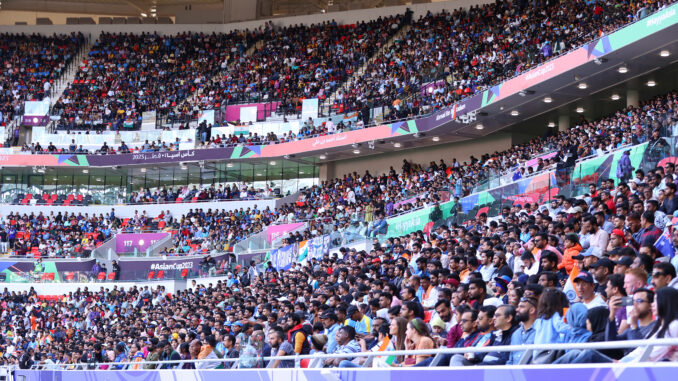
Just half an hour before India’s match against Australia kicked off, Faisal was still casting around for a ticket. In the tepid Doha heat outside of the Ahmad bin Ali Stadium, it seemed like a strenuous task, especially for an Asian Cup match.
Moments before, Faisal dispersed from an organised section – draped in blue and shades of yellow – as they drummed and sang in unison. By now Qatar Manjappada – the country’s chapter of the famed Kerala Blasters supporters group – has established itself as the beating heart of footballing events in Doha. That elevates when the Blue Tigers come to town.
“I was a part of the Manjappada in Kerala,” Faisal says as he tries to leverage that and his t-shirt to get a ticket. “I have the tickets for the next two matches, but I cannot miss out on this one.”
And he is not alone. Earnest Francis, one of the drum-bearers for the crew has been busy dealing with ticket requests as much as he is busy organising the mass as they head into the stadium. The group will chant and make up for the most vibrant section in the match as well as for the rest of India’s games.
“It has been a busy day,” he says as the members pack a large Indian flag as people gather to capture photos of the group. “India are playing a World Cup side, which is a big occasion. The excitement is at a different level today.”
Growing interest
Things in Doha, however, were not always this way for the Indian national team. Qualifying for the continental championship after 27 long years, some 9000 fans attended Australia’s 4-0 drubbing of India in the 2011 Asian Cup. Despite a third of Qatar’s population being expatriates from India, the national team was not as much celebrated even inside India, less so amongst the non-residential population.
A crowd of 36,000 strong on Saturday with a mix of people from all backgrounds and walks of life hints at a shift. Indian football has come a long way since that defeat 13 years ago.
The inauguration of the Indian Super League in 2014 coincided with the development of a new crop of players, and the first back-to-back Asian Cup qualifications in history has fostered interest in a national team that has always struggled to build identity under cricket’s dominance.
That was apparent at the SAFF Championships played last year in Bangalore’s Sree Kanteerava Stadium. More than 20,000 turned up to watch India lift South Asia’s premier competition for a record ninth time – defeating invitational sides Lebanon and Kuwait along the way.
While a crowd of that magnitude might not seem much for a country of 1.4 billion, even this looked distant a decade ago, despite being a force in the sub-continent.
Indian captain Sunil Chhetri has been omnipresent to see and craft it all – from playing in empty stadiums to becoming a de-facto home team in Qatar.
Still going strong at 39 years of age, he has dreamed and fought for Indian football’s recognition, becoming the poster boy and bagging some 93 international goals in the process.
“It is amazing to play outside of your country and get that kind of support,” he told The Asian Game after the Australia clash. “We would have loved to give them something to cheer for, but I hope they come back in the next games and we can give them something to be happy about.”
The only other player to be a part of both the 2011 and 2023 Asian Cup sides, goalkeeper Gurpreet Singh Sandhu, understands the importance of maintaining performances to cater to the growing interest.
“Our captain told us we should play for the crowd,” he said. “It should have been better but we now need to wrap it off and move on to the upcoming two matches.”
The Road Ahead
Termed as the “sleeping giants of football” by former FIFA president Sepp Blatter, growing interest in Indian football comes on the back of tangible progress, particularly under Igor Stimac, and the potential going forward.
One of the most prominent performances that is emblematic of the progress and the potential, coincidentally, came in Doha in 2019. In front of a sold-out crowd, including the Manjappada’s persistent drumming, India held Asian champions Qatar to a 0-0 draw, putting up a fight that looked very similar to the first-half performance on Saturday – resolute, courageous, fueled by a lively presence.
“[The] giant is definitely out of its slumber now,” India’s head coach Igor Stimac said before the Asian Cup kicked off. “We started working on changing the identity of the Indian team as soon as I took charge. We are well aware that we are far away from the top sides in Asia, but the potential is there.”
If anything, the expansion of the World Cup to 48 teams, guaranteeing eight spots for Asia, has furthered the need to advance quicker to qualify as soon as realistically possible. Stimac has been vocal with his demands, saying the country needs to act fast to bridge the gap that exists between themselves and the top Asian sides, frequently echoed by his players.
“It was not easy to play the best team in Asia,” Chhetri told The Asian Game. “We are not used to playing sides like these. The next step is to play these sides more frequently to get to the next stage.”
The 2-0 loss on Saturday served both as a testament, as well as a reality check to those aspirations. Despite starting strong, India was punished for their fatal errors and “never knew what to expect” according to the Indian captain.
“The team lacks consistency,” Saswat Biswas, an Indian student in Doha said, echoing the Indian captain’s wish to play above their level to learn from experiences, adding that India can grab points from the next two games if they “turn up.”
The first of those two games will be the Uzbekistan clash on Thursday, a clash that Manjappada and Faisal will attend and see the team build on the positives from the Australia clash.
If anything, the major difference from 2011 has been exactly that – from watching the national team participate to watching them do well.
Photo: Asian Football Confederation
Listen to The Asian Game Podcast as we discuss India’s prospects with Indian Super League commentator Erik Paartalu




